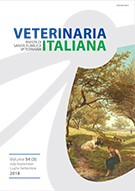Species of Mycoplasma causing contagious agalactia in small ruminants in Northwest Iran
DOI:
https://doi.org/10.12834/VetIt.831.4072.2Abstract
Contagious agalactia (CA) is a serious disease of small ruminants that occurs in many countries, and is usually characterized by mastitis, arthritis, keratoconjunctivitis, pleuropneumonia, and septicemia. Mycoplasma agalactiae (Ma) is the main causative agent in sheep and goats but other pathogens including Mycoplasma mycoides subsp. capri (Mmc, which incorporates the former M. mycoides subsp. mycoides Large Colony type), Mycoplasma capricolum subsp. capricolum (Mcc), and Mycoplasma putrefaciens (Mp) might be involved. They are all usually associated with infections in goats and may cause similar clinical signs. A total of 116 sheep and 16 goats suffering from the acute form of the disease were included in this study. They were recruited following a number of outbreaks suspected to be CA in the Ardebil province of Iran. Milk, lachrymal or synovial fluid were collected exclusively from the affected animals in order to identify the pathogen involved. Of the 132 collected samples, 33 (25%) were positive for Mycoplasma species by culture in PPLO broth and agar. The polymerase chain reaction followed by denaturing gradient gel electrophoresis (PCR/DGGE) method identified 18 (12 sheep and 6 goats) of the 33 Mycoplasma positive samples with mixed Mycoplasma population. In particular, 25 Ma (47.2%), 23 Mp (43.4%), 4 Mcc (7.5%), and 1 Mmc (1.9%) were identified. This confirms that the several Mycoplasma species rather than the Ma only are in circulation, and are able to cause CA in sheep and goats in Iran. This is the first report on the isolation and identification of Mp, Mmc and Mcc in infected small ruminant flocks in Iran.Downloads
Published
2019-01-04
How to Cite
Hajizadeh, A., Ghaderi, R., & Ayling, R. D. (2019). Species of Mycoplasma causing contagious agalactia in small ruminants in Northwest Iran. Veterinaria Italiana, 54(3), 205–210. https://doi.org/10.12834/VetIt.831.4072.2
Issue
Topics*
Paper



